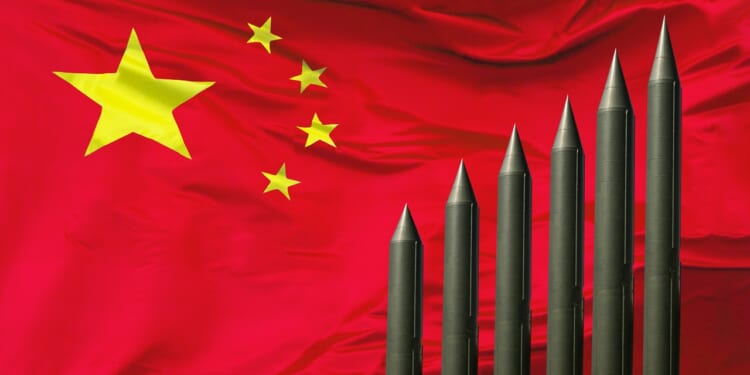China now appears to be able to detect most incoming missiles to its territory. Whether it can actually intercept those missiles is another question entirely.
China wants the world to think that it has cracked the code to national missile defense. A recent announcement from Beijing has gone viral across social media detailing how China allegedly successfully tested a sensor system that can identify and track up to 1,000 incoming missiles at once.
This is a major advancement for Beijing, to be sure. But that isn’t really the issue at stake. After all, what good is being able to track up to 1,000 incoming missiles if you can’t reliably shoot them down?
Seeing Is Not Always Enough
This has always been the main problem with national missile defense, along with the systems’ cost. It’s very helpful to be able to see these missiles coming in. But this needs to be followed up by the all-important second step—shooting as many of those missiles down as possible—or you’re basically just getting a front-row seat to your own demise.
And this is the problem that no country has really cracked. The only one thus far that has even come close has been the Israelis, with their various Iron Dome, David’s Sling, and soon-to-be-deployed Iron Beam laser defense systems. Many of these systems, notably the Iron Dome and Iron Beam, were developed in close coordination with the United States—a tangible instance where Israeli security cooperation significantly benefited the United States. The co-development of the Iron Dome and Iron Beam air defense systems between the Pentagon and the Israeli military has been key for America to streamline its on-again-off-again attempts to build a viable missile defense shield for the United States.
A History of US Ballistic Missile Defense (BMD)
Since the 1980s, when then-President Ronald Reagan first put forward his calls for a national missile defense shield utilizing lasers—ridiculed as “Star Wars” at the time—the scientific community has argued that the technology simply is not available to effectively create a national missile defense shield.
Indeed, in the 1980s and 1990s, this was a fair claim—even if it was being advanced for disingenuous reasons. Today, however, that claim no longer holds muster. The United States is now pushing the science and technology for viable missile defense shields forward. Of course, there are still limits to the current technology, and those limits are being tested regularly by the swarming tactics of rivals like Iran, in its war against Israel.
Nevertheless, the Americans, thanks to their partners, do have at least rudimentary shootdown capabilities that, under conditions, the Chinese thus far lack. Here’s where things get tricky, though. And it’s mostly because the United States has not fully committed itself to build the one system it absolutely needs to protect itself from incoming enemy missiles.
America Needs to Focus on High-Tech Missile Interceptors
Allies like Israel have helped keep the United States competitive in the development of these critical systems. So, too, has Japan with its recent breakthroughs in directed energy weapons (DEWs) at a time when the US Navy abandoned their 20-year-long efforts to build such weapons.
With China’s advances in sophisticated sensors, artificial intelligence (AI), and their own successful DEW program, it is catching up to the Americans and their allies. Therefore, while the Chinese currently lack an actual national missile defense shield, given their unity of effort, Beijing will be at parity with the United States soon.
The Americans have a crucial edge here: access to allied programs like Israel’s Iron Dome and Iron Beam and Japan’s naval DEWs. If Washington follows through on Trump’s “Golden Dome” spending plans, the US can achieve its own reliable missile defense shield within the decade.
Accordingly, even though China appears to have beaten the Americans to the punch on the tracking component for a national missile defense system (the tracking component, that advantage is far from decisive. The key element that the Trump team must focus on, and move quickly toward developing, is the actual interception component of a national missile defense shield.
Who cares if China fielded a prototype system first? The Soviets beat the Americans to space, and they still lost both the Space Race and the Cold War. But America has to get moving now.
About the Author: Brandon J. Weichert
Brandon J. Weichert is a senior national security editor at The National Interest. Recently, Weichert became the host of The National Security Hour on America Outloud News and iHeartRadio, where he discusses national security policy every Wednesday at 8pm Eastern. He is also a contributor at Popular Mechanics and has consulted regularly with various government institutions and private organizations on geopolitical issues. Weichert’s writings have appeared in multiple publications, including The Washington Times, National Review, The American Spectator, MSN, The Asia Times, and others. His books include Winning Space: How America Remains a Superpower, Biohacked: China’s Race to Control Life, and The Shadow War: Iran’s Quest for Supremacy. His newest book, A Disaster of Our Own Making: How the West Lost Ukraine is available for purchase wherever books are sold. He can be followed via Twitter @WeTheBrandon.
Image: Shutterstock / photoeu.
















